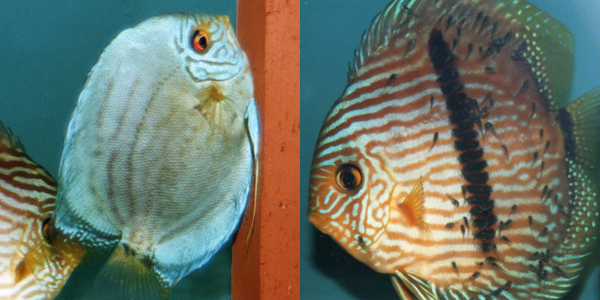Heckel discus have a reputation for being difficult to breed in captivity. Over ten years ago, I was lucky to find 3-inch (7.5 cm) wild Heckel discus for sale at a local fish store. I bought two and raised them to adulthood with various other discus species and strains. About eight months after acquiring the Heckel discus, one paired up with a female cobalt blue discus. This discus pair was one of the most productive pairs I have ever owned. They were great parents and produced many fry, which most were sold to wholesalers in Los Angeles and Sacramento, California.

This pair's first spawning was allowed to occur in a community aquarium. Allowing a new pair of discus to spawn in a community tank before you remove them solidifies their bond and makes it more likely they will spawn again after being moved. In most cases, discus will eat their first few spawns, so removing them from the community tank before they spawn would be of no benefit.
After being moved to a tank of their own, the pair quickly began producing fry. I use a red clay brick for a vertical spawning surface in many of my discus breeding tanks. At about 2 1/2 days post spawning at 85° F (29.5° C), the eggs begin to hatch. Once the eggs start to hatch, the parents help pick the fry free of the egg shells. The fry are often moved to a new vertical surface where the parents will tend to them. After three days as wrigglers, the fry will start to free swim. It is at this time that the fry look for the parents so they can then begin feeding on their sides. You can see when the fry have been feeding on the parents as their transparent bellies will appear white. The fry feed exclusively on the parent's slime coat for four days and will not have any interest in any other prey in the tank, so no food is added for the fry to the tank during this time.

On the fifth day of free swimming, the fry will start to look for additional food sources in the water column. At this time, a very small amount of live newly hatched brine shrimp is offered three times a day. Usually, by the 7th or 8th day of free swimming, the fry will be gorging on live newly hatched brine shrimp to the point where their bellies turn orange. I usually will remove the fry after they have been free swimming for 11 days, as they can be raised completely independent of the parents at this time. The fry will continue to be fed live newly hatched brine shrimp for three weeks. At three weeks of age, I then begin transitioning the fry over to my beef heart formula. By the time the fry are one month old, they are fed 3 times a day exclusively on my beef heart formula. At one month of age, the fry are about 3/4 inch (2 cm) long and already have the discus shape.
At about three months of age, it was apparent that the bold center Heckel bar was not the dominant gene. Only about 25% of the offspring showed any bold center Heckel bar; of that 25%, the bolded bar was patchy.

Most of the offspring were sold when they reached five months of age, but I kept a few for myself to see how the adult offspring of this crossing would turn out. The offspring looked like a turquoise discus with fairly even horizontal striping.
My experience with Heckel discus is similar to that with any other discus. I found them to be just as hardy as any other discus I have ever kept. The key to success with wild discus is to try to find juveniles and raise them in captivity. I have bred other wild discus, which were also obtained as juveniles. I have never had any luck with breeding wild discus that were already adults when shipped to the US. The crossing of Heckel and the cobalt blue discus produced fish with great color and a perfect discus body shape.
